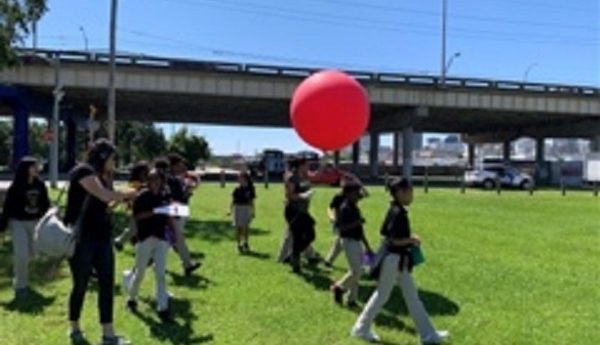By Anne Johnson
Two organizations with different origin stories share a vision for community science. What can we accomplish together?
You know that inflection point when kids go from “parallel play”—being in the same sandbox but exploring completely separate imaginary worlds—to actually playing together, inventing games and rules and creations?
Thriving Earth Exchange and Public Lab have long played in the same sandbox. Now, with support from the Gordon and Betty Moore Foundation, our two organizations are embarking on a partnership to learn how we can do more by working together.
Public Lab started shortly after the 2010 BP oil disaster, when Gulf Coast residents teamed up with environmental advocates, designers and social scientists to document how the spill was altering their environment. Today, it’s a worldwide community of local activists, educators and researchers, supported by a 501(c)3 non-profit, that applies open-source tools to environmental exploration and investigation.
Thriving Earth Exchange was founded in 2013 as our parent organization, the American Geophysical Union, looked to renew its commitment to leverage science to benefit humanity in honor of its 100th anniversary. Today, we’re approaching our 100th project as an initiative that brings together communities and scientists to advance community priorities, with a direct impact on an estimated 17.5 million people.
From sharing a vocabulary to amplifying impacts
Both organizations call our work “community science,” an approach to asking and answering questions that’s grounded in community-generated priorities, knowledge and action.
“Public Lab and Thriving Earth Exchange have lots of commonalities,” says Public Lab Executive Director and Co-Founder Shannon Dosemagen. “Most importantly, we are both committed to centering our work on solving questions that come from communities. Our methodology in doing this is centered on equity in relationships and ensuring that different types of knowledge (from local to academic) can exist alongside each other.”
With that shared framework, Dosemagen and Thriving Earth Exchange Director Raj Pandya believe the organizations will find plenty of fertile ground for super-charging their projects and achieving an even bigger impact.
“I think by working together we help communities do more of what they want to do, we help scientists collaborate better with communities, we advance communities awareness and support for science, and we help address global issues like environmental justice and climate change, one community at a time,” says Pandya. “Impacts in more communities, sooner—that is what we accomplish together.”
Finding strength in differences
Although the organizations share a vision, they came to the sandbox from different places. Public Lab emerged organically as a grassroots community effort, while Thriving Earth Exchange took a more directed approach starting from an institutional framework. Along the way, each developed its own way of meeting communities where they are.
“Public Lab and Thriving Earth both offer communities and individuals the opportunity to guide, participate in, and benefit from science,” says Pandya. “Thriving Earth does it by connecting communities to scientists and science institutions, while Public Lab does it by connecting communities to other communities who are already doing science.”
Each organization also offers a unique skillset, resources and network. For example, Public Lab brings to the table a powerful online resource sharing platform for people to engage in environmental problem-solving, while Thriving Earth Exchange has honed the art of leveraging scientific partners and expertise to contribute to community-driven efforts.
“I see our differences as strengths in this emerging partnership,” says Dosemagen. “Thriving Earth brings an extensive scientific network from AGU with them, Public Lab staff are community organizers and facilitators. Thriving Earth has a formula for engagement and determining impact, while Public Lab is more fluid in project duration and outcomes. I think there is a lot we can learn from each other and the unique skills shared by our staff and communities.”
Inspired to act
Teams from the two organizations gathered recently to start fleshing out what their new working relationship will look like on the ground. Initial plans include co-designing a campaign to help scientists understand the importance and value of their participation in community science projects, connecting and sharing resources, and cross-posting Thriving Earth Exchange projects on PublicLab.org. In the longer term, teams are looking at ways to harmonize their efforts to support new and existing projects in local communities.
“I’m excited about this partnership and think that it is coming at a critical time—we need as many problem-solvers as possible to address the increasing number of environmental issues that we collectively are facing,” says Dosemagen.

